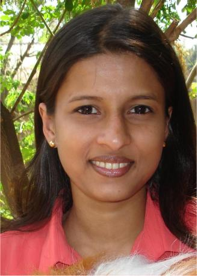Integration of micro-cantilevers with photonic structures for mechano-optical wavelength selective devices
Promotion date: 06. April 2011
Promotor: Prof. Dr. Gijs Krijnen
| This thesis deals with the fabrication technology and mechano-optical characterization of compact integrated wavelength selective optical devices. Owing to their ease of fabrication and low power consumption, electrostatically actuated curled micro-bimorph cantilevers are chosen as the mechanical perturbing element. Using surface micromachining techniques, micro-cantilevers are monolithically integrated with three different types of optical devices such as a micro-ring resonator, a photonic crystal slab waveguide, and a photonic crystal micro-cavity based device. These integrated devices are further mechano-optically characterized. |
Is your type of research internationally important?
Yes, it is. The thesis deals with silicon based mechano-optical modulators for use in telecommunication applications. This type of optical modulator is more attractive than the other existing methods due to its low power consumption, higher tuning range and speed. The application can further be extended to short-distant on chip interconnects and even in optical sensing networks.
Was there an important moment during the thesis project that you remember very well?
There were quite a few. Specifically in the third year, we were able to fabricate self-aligned nano-tips with respect to the holes of a photonic crystal. This was realised using conventional photolithography facilities available in the MESA+ cleanroom, which was very challenging. This new self-aligning technology allows for the fabrication of a new class of integrated optical devices. Especially this result has attracted much attention from scientists at international conferences.
Did you have some papers published?
Yes, one in the Journal of Micromechanics and Micro-engineering. Already four more articles are submitted to peer reviewed journals. Further the work was presented in some prestigious conferences in our field like IEEE MEMS 2011 and in Transducers’ 2011.
How did you develop as a researcher or as a scientist?
The multidisciplinary nature of the project has helped me to expertise different fields such as micromechanics, micromachining and integrated optics. It was also required to develop my skills into both theoretical and experimental aspects of the project. Further the collaborative nature of the project improved my soft skills. My supervisor Gijs Krijnen also had a good impact on developing me into such an independent researcher. This experience will help me to tackle problems in a more systematic way now.
What are your future plans?
Right now I am working as a postdoctoral researcher at the Molecular Nanofabrication Group of University of Twente. My current project aims to develop a fabrication process for Nanostructured Arrays, using Nano Imprint Lithography. This research will have application in nano-Bragg-Fresnel optics for the XUV wavelength range and in inter-digital transducers for the generation and detection of high frequency surface acoustic waves. In the near future, I am intending to move into industry where I wish to visualise my research being developed into real products, used by society.
What, in your opinion, is important for MESA+ to stay successful in the future?
The facilities at MESA+ are world-class and the expertise of the technicians can spare you a lot of time as a researcher. Further I benefited a lot from the MESA+ Day, to know more about the research activities within the University. Perhaps a MESA+ day twice in an year will be a good idea to have better collaboration between the research groups of University.

